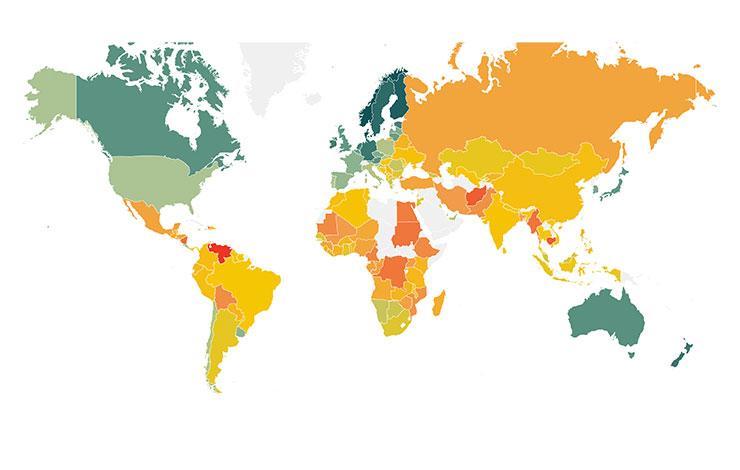
 This post originally appeared at the Stanford Social Innovation Review (SSIR) on 28 April 2014.
This post originally appeared at the Stanford Social Innovation Review (SSIR) on 28 April 2014.
Last year, in the West Point township of Monrovia, the capital city of Liberia, an enterprising community leader named Thomas Tweh found himself with a serious problem. West Point crams more than 75,000 citizens into a square mile patch of land by the Atlantic Ocean—and life is very hard. Space is limited, incomes are low, formal jobs are few, and basic services are almost non-existent.
The issue Tweh faced was central to the causes of these difficulties: justice. “The people are coming to me every day—they have no justice,” he told me at the time. “There are disputes over land, domestic violence, bad loans—and the courts can’t deal with these problems.” If you spend any time in West Point, it soon becomes clear that he is right—the formal justice system is slow, over-burdened, lacks capacity, and provides ample opportunity for corruption. Public trust in the law is very low.
With the inspiration to find better ways to ensure justice and accountability for the population of West Point, our team at the Accountability Lab sat down for a series of discussions with Tweh using a design-thinking approach. We gathered all available research on justice and accountability issues in West Point, spent time in the community talking to as many citizens as we could, and then began to think about possible solutions to the problem.
After we came up with a number of ideas that seemed unfeasible, the parameters of a workable project became clear: a top-down process of collaborating with the courts to refer cases back to the community (saving time and money, and reducing the burden on the formal system), combined with a bottom-up program to train community members as mediators to resolve disputes sustainably as part of a Community Justice Team (CJT).
We had high hopes. We worked with Tweh to carefully select and train community mediators and a notary to document the cases. Tweh spoke to the local police and court to secure collaboration. We also conducted outreach activities to make people in West Point aware of this new service.
Everything worked brilliantly—except for the fact that no one used the system. We couldn’t work out why not—did the community need more of a sense of ownership? Was the mediation office too far away for people to get to easily, or did they not trust the mediators? As we began to ideate—in design thinking, the process of testing competing ideas—we realized that there were two very different problems. First, most crimes, disputes, and conflicts in West Point happen after dark or at the weekends, when our mediators were not available to help resolve them quickly. Second, despite our public meetings, posters, radio, and word-of-mouth efforts, people didn’t know about our system.
In response, we made sure that the mediators could rotate their shifts and were ready to step-in when needed at all times. They also began to go out to the community rather than waiting in the office for cases to come to them. We also bought a megaphone and hired a town crier to walk around West Point early in the mornings and remind people to use the mediation service as they began their days. This gave the service a more human face than radio announcements.
Suddenly, implementation took off—residents of West Point began to come to the CJT, which successfully settled disputes such as non-payment of child support and illegal construction. Since July last year, the CJT has resolved 76 cases without any recidivism and with the full cooperation of the authorities. This project is small, but for a total investment of around $3,000, we estimate that the CJT has saved citizens more than $7,300 in bond, administrative, and travel fees, and approximately 350 days of time that they otherwise would have spent navigating the court system. Not a bad accountability “return on investment.” (You can watch a video of Tweh and the CJT in action in West Point here).
The design thinking approach helped us understand how to make this service more people-centered and effective over time. It also helped us refine the model in response to feedback and build a communications strategy that works. As a result, we have managed to raise additional funding for the model and are coordinating with the Liberian Ministry of Interior’s Peace-Building Office and Trust Africa to scale-up the approach in other low-income, high-density parts of Monrovia.
Inspired by these experiences and after recently spending some time at Stanford’s d.school (as part of theExecutive Program on Social Entrepreneurship), the Accountability Lab is now applying the design-thinking approach to other areas of our work, on issues of form as well as function. In terms of reporting, for example, rather than asking local partners to fill out long surveys or matrices in English, we’ve designed periodic “accountability collectives,” or oral progress sharing sessions. We take notes during these sessions to fulfill our reporting requirements, and use the time to brainstorm new ideas, see where synergies might lie, and support each other. It is a contextualized, productive, and fun way to understand the impact that our work is having and create opportunities for new thinking.
At the outset of the West Point project, we didn’t realize that what we were doing was “design-thinking” per se, but now we’re using the concepts to support other projects such as an accountability film school in Liberia and a portal to crowd-source public information for citizens in Nepal. Recently, I walked with Tweh around the narrow, crowded alleyways of West Point one afternoon. As he stepped around small children washing themselves next to open sewers he asked, “We’ve designed a program that is helping with justice—can we do the same for sanitation and education?”
*********
Photo Credit: West Point Health & Sanitation/Morgana Wingard for Accountability Lab






